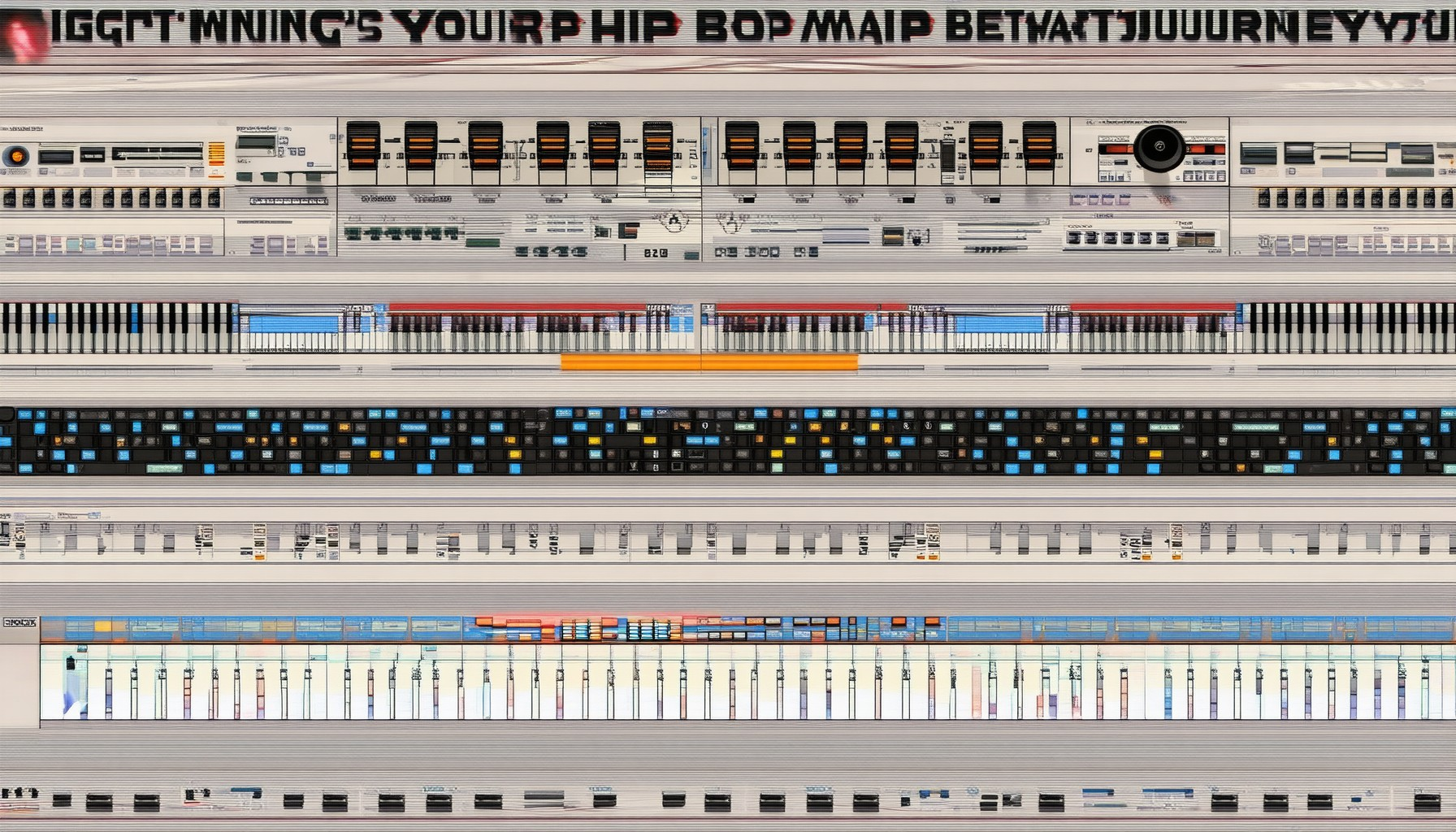Creating the perfect hip hop beat is an art form that combines creativity, technique, and a deep understanding of rhythm and melody. Whether you’re a seasoned beatmaker or just starting your journey, mastering the craft requires the right tools, knowledge, and mindset. In this comprehensive guide, we’ll explore everything you need to know to become a skilled hip hop beatmaker, from essential tools and techniques to valuable resources and expert tips. Discover how to craft beats that stand out, avoid common mistakes, and leverage the latest tools to elevate your sound. Let’s ignite your hip hop beatmaker journey and unlock the secrets to creating beats that inspire and captivate.
Key Takeaways
- Hardware Essentials: Utilize turntables, CDJ mixers, high-quality speakers, and studio headphones for authentic sound production.
- Software & Plugins: Leverage DAWs like Ableton Live, Logic Pro X, and FL Studio, and explore sample libraries from Splice and AudioMedia, along with effect plugins from Plug-In Here and iZotope.
- Production Techniques: Master sampling, looping, beat matching, and sound design to craft unique beats.
- Competitors & Resources: Draw inspiration from Abstract Hip Hop, DJ Booth, and Resident Advisor for diverse creative perspectives.
- Getting Started Tips: Begin by learning from mentors, experimenting with loops, and using free sample packs to build your beats.
- Standout Beat Elements: Focus on rhythm, melody, lyrical content, originality, production quality, soul, and layered elements to create impactful tracks.

Essential Tools and Steps for Creating a Hip-Hop Beat
1. Essential Tools
- DAW (Digital Audio Workstation): Use software like Ableton Live or FL Studio for recording, editing, and mixing.
- Sample Libraries: Invest in high-quality sample packs from reputable sources like Splice or AudioBomBSix .
- Synthesizers: Utilize soft synths like Massive or Xpand!2 for creating basslines and textures.
- Drum Machines: Use hardware or software drum machines like Akai MPC for precise drum patterns and sequencing.
- Headphones: High-quality headphones like Sennheiser are essential for mixing and mastering.
- MIDI Controllers: Use a MIDI controller like M-Audio to play notes and chords live during production.
- Mastering Plugins: Use plugins like iZotope Oxygen for vocal and instrumental processing.
2. Steps to Create a Hip-Hop Beat
- Select Tools and Setup: Choose your DAW, sample library, and hardware. Set up your workspace with your MIDI controller and headphones.
- Sampling and Loops: Sample vinyl records, drums, and vocals. Use loop manipulation to create dynamic sections in your track.
- Beat Construction: Program your drum machine with tight, rhythmic patterns. Use synthesizers to create basslines and pad layers.
- Arrangement and Layering: Build your track by layering beats, samples, and melodies. Use automation to tweak envelope controls for dynamic sounds.
- Mixing Techniques: Use compressors, equalizers, and reverb to shape your mix. Pay attention to stereo imaging and space.
- Mastering: Apply final touches with volume adjustments, compression, and limiting. Mastering plugins can help achieve a professional finish.
- Collaborate and Feedback: Share your work with trusted collaborators for feedback. Incorporate their suggestions to refine your track.
- Stay Updated: Follow producers and platforms like SoundCloud and Beatport to stay ahead in the latest trends.
What are the best resources for learning to create hip-hop beats?
Creating hip-hop beats requires a blend of creativity, technical skills, and knowledge of the genre’s history. Here are some top resources to help you get started:
- Abstract Hip Hop – Explore in-depth articles, production tips, and interviews with beatmakers on AbstractHipHop.com . This platform is perfect for those interested in experimental and avant-garde styles.
- SoundCloud – Follow producers like Jinsang, Nujabes, and DJ Premier to study their sound design and composition techniques. Many creators share their production processes and tips on their SoundCloud pages.
- YouTube Channels – Channels like Illmatic Sounds and Defected Records offer tutorials, behind-the-scenes videos, and live performances from top beatmakers.
- Beatmaking Workshops – Attend local or online workshops hosted by experienced producers. These sessions often include hands-on projects, feedback, and networking opportunities.
- Splice – Use Splice to access high-quality samples, loops, and production guides. Their platform also offers courses and collaboration tools for beatmakers at all levels.
Mastering hip-hop beat creation takes time and practice. Dedication to studying these resources and experimenting with different sounds will help you develop your own unique style.

Top Tools and Techniques for Creating Hip-Hop Beats
Creating hip-hop beats involves a combination of creative techniques and the use of specialized tools. Below is a breakdown of the essential tools and techniques that every beatmaker should know:
Essential Tools for Beat-Making
- Digital Audio Workstations (DAWs): Popular DAWs like Ableton Live , Famous Studios , and Mackie Tracktion offer powerful features for beat creation. These tools allow you to manipulate samples, program drums, and mix tracks effectively.
- Sample Chop Tools: Software like Xp-Packer and SampleNet Lion simplifies the process of chopping and rearranging audio samples, which is a cornerstone of hip-hop production.
- MIDI Controllers: Using a MIDI controller with your DAW allows for precise control over notes and rhythms. Brands like M-Audio and Native Instruments offer versatile options for beat-makers.
- VST Plugins: Effects plugins like ToneBoosters EQ 8 and AMS Neumann Tracktion are essential for shaping the sound of your beats.
- Live Instruments: Hardware samplers like the Akai MPC Minino 25 and SP-404 Samplr Rate provide real-time sampling capabilities, allowing for dynamic beat creation.
Key Techniques for Beat-Making
- Sample Chopping and Manipulation: This technique involves taking snippets of audio and recontextualizing them to create unique rhythms and melodies. Tools like Serum and SampleNet Lion excel in this aspect.
- Drum Programming: Using DAWs and MIDI controllers, you can programmatically create intricate drum patterns. This is particularly useful for producing complex rhythm structures found in modern hip-hop tracks.
- Loop Manipulation: Loops are a staple in hip-hop production. Techniques like time-stretching, pitch-shifting, and reverse engineering loops can lead to fresh and original sounds.
- Effect Processing: Effects like reverb, delay, and distortion add depth and texture to your beats. Plugins like ToneBoosters Reverb 8 and AMS Neumann Tracktion are great for this purpose.
- Mixing and Mastering: Even the most skilled beat-makers need a good mix. Tools like Audient EVO 4 and M-Audio Interface VSL 3 provide high-quality preamps and clean gain staging for a polished finish.
Final Thoughts
Beat-making is a deeply personal and creative process. Whether you’re using hardware samplers, DAWs, or plug-ins, the key is to stay inspired and keep experimenting. Resources like Abstract Hip Hop can provide further insights and inspiration for your journey in creating authentic hip-hop beats.

Essential Tools and Techniques Used by Professional Hip Hop Beatmakers
Creating powerful hip hop beats requires a combination of skill, creativity, and the right tools. Here’s a breakdown of the essential tools, techniques, and approaches used by experienced beatmakers:
Hardware Essentials
- Turntables: Vinyl records remain a cornerstone of hip hop production, offering authentic scratch effects and vinyl warmth.
- CDJ Mixers: Digital mixers allow for precise control over audio levels and effects during live performances.
- Speakers: High-quality speakers are crucial for monitoring mixes and ensuring accurate sound reproduction.
- Headphones: Studio headphones help in hearing subtle nuances and refining beats.
Software and Plugins
- Digital Audio Workstations (DAWs): Popular choices include Ableton Live, Logic Pro X, and FL Studio. These platforms offer robust editing tools and automation capabilities.
- Sample Libraries: Websites like Splice and AudioMedia provide high-quality samples that inspire fresh beats.
- Effect Plugins: Reverb, delay, and compression plugins are staples in hip hop production. Brands like Plug-In Here and iZotope offer industry-leading options.
Production Techniques
- Sampling and Chopping: Beatmakers often sample snippets from vinyl records, CDs, or digital files and manipulate them to create unique sounds.
- Looping and Layering: Loops are a fundamental technique in hip hop, allowing for intricate layering of rhythms and melodies.
- Beat Matching: Syncing beats from different sources ensures smooth transitions during performances.
- Sound Design: Experimenting with effects and pitch shifting creates distinct sonic signatures that set beats apart.
Competitors and Influences
While we’re focused on Abstract Hip Hop , it’s important to acknowledge the broader hip hop community. Competitors like DJ Booth and Resident Advisor offer valuable resources and inspiration for aspiring beatmakers.
Getting Started
For those looking to improve their skills, we recommend:
- Learning from Mentors: Collaborate with experienced producers or watch tutorials from artists like Jazzy Jeff or DJ Premier.
- Experimenting with Loops: Start with simple loops and gradually incorporate more complex patterns.
- Exploring Samples: Use free sample packs to build your own beats before investing in premium libraries.
With the right tools and techniques, anyone can develop a signature sound in hip hop production. Keep experimenting, stay curious, and never stop learning!
What Are the Key Elements That Make a Hip Hop Beat Stand Out?
A hip hop beat is more than just a simple rhythm—it’s a powerful combination of various elements that come together to create something unforgettable. Here are the key components that make a hip hop beat stand out:
- Rhythm and Timing : The foundation of any great hip hop beat lies in its rhythm and timing. A tight, consistent kick drum pattern often serves as the backbone, while the snare and hi-hat provide the energy and groove. The way these elements are spaced and timed creates a sense of momentum and movement.
- Melody and Hooks : While beats are often instrumental, a memorable melody or hook can elevate a track to iconic status. Whether it’s a catchy bassline, a soulful piano riff, or a haunting vocal sample, these elements stick in your mind long after the song ends.
- Production Quality : High-quality production is essential for a professional sound. Clean, crisp instrumentation and well-balanced mixes ensure that every element in the beat sits perfectly, allowing each part to shine without clashing.
- Emotional Impact : A great beat doesn’t just rely on technical skill—it connects with listeners on an emotional level. Whether it’s the aggression of a fast-paced track or the introspective vibe of a slower one, the beat should evoke a specific feeling that resonates with the audience.
- Layered Elements : Complex beats often feature multiple layers of sounds, from live drums to synthesized basslines and everything in between. These layers add depth and interest, making the beat more dynamic and engaging.
- Tempo Variation : A beat that changes tempo or shifts in timing can keep listeners on their toes. This technique adds unpredictability and keeps the energy levels high, preventing the track from becoming monotonous.
- Originality : Finally, the most important factor is originality. A beat that borrows heavily from others may lack the uniqueness that sets it apart. Originality shows creativity and innovation, which are key to standing out in the crowded world of hip hop.
If you’re looking to dive deeper into the world of hip hop beats, check out our Abstract Hip Hop platform. We offer in-depth analysis, exclusive interviews, and the latest trends in the genre, perfect for anyone who loves discovering the next big thing in music.

What Are the Key Elements That Make a Hip Hop Beat Stand Out?
A hip hop beat stands out due to several key elements that combine to create a unique and impactful sound. Here’s a breakdown of the most critical components:
- Rhythm and Tempo :
A hip hop beat is defined by its rhythmic foundation. The tempo, or speed, of the beat plays a vital role in setting the pace. While many beats use a 4/4 time signature, others experiment with offbeat rhythms or varying tempos to create a dynamic feel. A tight, locked-in rhythm is essential for maintaining energy and groove. - Melody and Hook :
A memorable melody or hook is often the backbone of a hit track. Whether it’s a catchy chorus or a solo that sticks in your mind, the melody adds emotional depth and relatability to the song. A well-crafted hook ensures the listener remembers the track long after it’s finished. - Lyrical Content :
Lyrics play a significant role in conveying the artist’s story or message. Thoughtful and meaningful lyrics can elevate a beat to something greater, giving it context and purpose. Artists who connect with their audience through words often find their music resonates more deeply. - Originality and Innovation :
The best hip hop beats don’t just mimic existing styles; they push boundaries. Whether it’s experimenting with new instruments, blending genres, or introducing fresh production techniques, originality keeps the artform evolving. A unique sound sets a beat apart from the pack. - Production Quality :
High-quality production is non-negotiable. A well-produced beat uses precise engineering to ensure every element sits perfectly in the mix. From the kick drum’s thump to the hi-hat’s crispness, attention to detail in production enhances the overall listening experience. - Soul and Feeling :
A truly great beat has a soulful essence that transcends mere instrumentation. It carries emotion, whether it’s the raw intensity of street vibes or the smooth, laid-back grooves of chill-hop. This intangible quality is what makes a beat resonate with listeners on a deeper level.
By combining these elements, a hip hop beat can become more than just music—it can tell a story, inspire emotions, and redefine expectations.





0 Comments